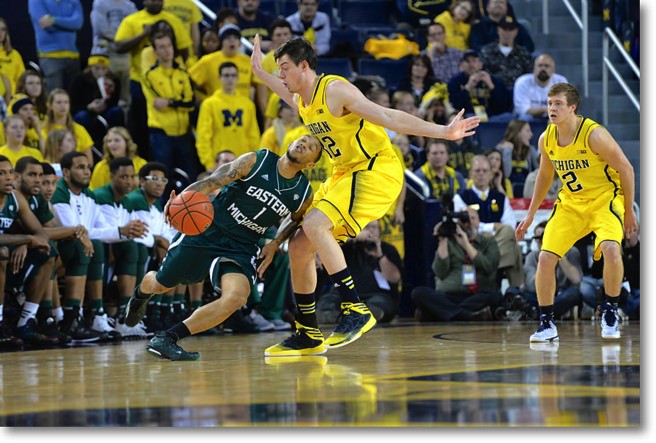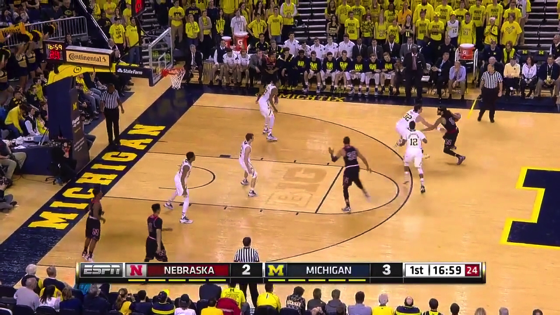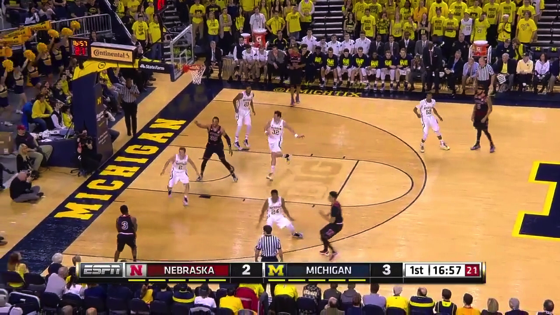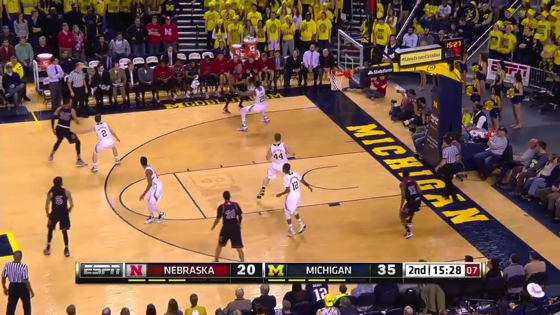Picture Pages: Defending The On-Ball Screen


This appears to be an effective hedge. [Fuller]
Brian directed me to an excellent Vantage Sports article detailing how NBA teams defend the on-ball screen earlier this week and suggested it would be a good idea to take a closer look at how Michigan does it. Before getting into the Wolverines specifically, a look at the three basic ways to defend this:
- Hard Hedge — The way M's done it the most under Beilein. The defender guarding the screener (usually a big man) aggressively slides out on the ballhandler to cut off a drive to the basket and make quick passes more difficult. This temporarily commits two defenders to the ballhandler and usually requires quick rotation from the other defenders on the court.
- Soft Show — A less aggressive approach that still briefly commits two defenders to the ballhandler, in this case the defender guarding the screener moves next to the screener, cutting off a drive directly to the hoop; he doesn't move all the way out on the ballhandler, however, and dives back to the screener after cutting off the initial drive. This still requires some weakside rotation.
- Drop Back — The conservative tack. The defender on the screener drops back (surprise!) into the paint, discouraging the ballhandler from driving while also lessening the burden on other defenders to rotate onto the roll man. This does require the defender on the ballhandler to fight over the screen well, otherwise there's room for a pull-up three.
As best I can tell, college teams favor the more aggressive approaches. This is likely due to two things: pro point guards are really damn good, and there's less space inside the arc to cover in college, making it easier to recover after a hard or soft hedge.
I went through the last three games—Rutgers, Wisconsin, and Nebraska—to see how Michigan defended the pick-and-roll. I found nine instances in which Michigan was in man defense against a P&R*; six times they hedged hard and three times they played a soft show. The results:
A few takeaways with picture pages after THE JUMP.
[JUMP]
Michigan still hard hedges most of the time. If you've watched the Wolverines under Beilein, this isn't a surprise. One of Jordan Morgan's hidden talents was his ability to cover the requisite ground quickly to make this effective.
Max Bielfeldt is better at this than Ricky Doyle. In part due to the fact that Bielfeldt is smaller and more mobile, in part because Bielfeldt is just more experienced, the lone senior on M's roster is most adept at the hard hedge. (I realize we're working with a tiny sample size here, but this is something I've noticed earlier this season, too.)
Here's a Doyle example (0:13 mark of the video). The setup—Walter Pitchford is setting a high screen for Terran Pettaway:

Doyle jumps out on Pettaway, as he's supposed to do, but while he prevents the drive he doesn't get his body into Pettaway.

This makes it way too easy for Pettaway to pull up and swing the ball around the perimeter. With Doyle still far away from recovering, Spike Albrecht is stuck guarding Pitchford in the post to prevent an easy dunk. Aubrey Dawkins is playing one-on-two on the near side. One pass...

Two pass...

Wide open three. (He made it.)
Let's compare that to an similar play in the second half run against Bielfeldt (0:37 mark). Pitchford sets a screen for Pettaway:

Bielfeldt takes a more aggressive angle than Doyle did, forcing Pettaway to give ground to avoid barreling over him:

Bielfeldt sticks with Pettaway as he ends up on the other side of the court, positioning himself so a pass is difficult:

Equally impressive is Bielfeldt's quick recovery. Pettaway is finally able to swing the ball back to Pitchford (who popped instead of rolled), and by the time Pitchford gets it to the corner, Bielfeldt is back under the basket, allowing Zak Irvin to closely contest the corner three:

The shot is an airball, and Bielfeldt identifies the Nebraska player sneaking in from the opposite corner, boxes him out, and helps corral the rebound:

This may be one of the reasons Michigan's played more zone as the season's moved on. Their best big man against the high screen is just 6'7" and prone to getting worked in the post by larger centers—Beilein tends to go zone immediately upon inserting Bielfeldt in the game.
Meanwhile, the freshman bigs don't have the technique of pick-and-roll defense down yet, and they're not quick to recover; the first couple clips in the video feature some slow rotations after the initial screen.
Incomplete data on the soft show... but I don't think I like it. The soft show only featured three times in the video—twice against Rutgers, a team so averse to running any semblance of an offense that it's tough to glean anything from watching them play.
It works fine against the half-assed screens set by Rutgers' big man in the first two clips—RU only gets a decent shot on the first one because Derrick Walton makes the unwise decision to leave his feet on the perimeter. The final clip shows what I don't like about it. Michigan doesn't have very good perimeter defenders, and without a hard hedge from the big, it's easy for the ballhandler to work his way into the lane. Nebraska didn't score on that possession, but they got the ball to a big man in solid post position after Terran Smith managed to work his way into the paint.
Any conclusions? I'm still of the mind that this Michigan squad needs to be a majority zone team, and this exercise didn't do much to change that opinion.
*Remember, they've played a ton of zone recently.
January 30th, 2015 at 3:12 PM ^
Nice write up Ace, as with most things there are advantages/disadvantages to each...the biggest disadvantage to the hard hedge in my opinion is it puts the big in a precarious position to pick up a cheap blocking foul. Another possible option is the "squeeze method" (my terminology). In my opinion this is most effective vs guards that are good at penetrating the lane and creating for others, not very good on guards with the ability to shoot. The squeeze involves the big man guarding the screener basically hugging his man and allowing the guard to go under neath the screen. By squeezing it prevents the picker from rolling into the defending guard. As I said it can be very effective vs guards that are unable to shoot off the dribble. I think UM has done a pretty good job at defending the ball screens so far but I also think that there are teams on the schedule left that are more adept at efficiently using the P & R with greater rates of success.
January 30th, 2015 at 8:56 PM ^
You can press up on ball screens. To me it's more effective when the big man is more a threat than the guard. You're really messing with the big's rhythm, timing, and spacing (if your guy is good at pressing up) when you do this. But you're giving the guard a free pass into space, and by sending your guard underneath, you're giving their guard a shot if he likes.
If the guard isn't that big a threat, I generally prefer to tell both players to sag. Bigs who can pick and pop you can usually close out on fast enough, and if the guard is more a driving threat and not a shooting threat to speak of, then just let them dick around out there on the perimeter. Sag off and start defending them when they come into a range where they can hurt you.
January 30th, 2015 at 3:19 PM ^
January 30th, 2015 at 4:06 PM ^
A lot of it depends on the quickness of the big man being able to stay in front of a guard (tough to do) and recover into the paint quickly. Doyle may not have that athleticism. Great write up, Ace.
January 30th, 2015 at 3:27 PM ^
That is all.
January 30th, 2015 at 3:34 PM ^
Seemed like a big part of that video study was Wisconsin knew where to find the open man and Nebraska didn't.
January 30th, 2015 at 3:40 PM ^
Seems like MA-AR was at fault on the first example. He is responsible for the throwback across the court with led to the wide open three. He has to allow Doyle to get tight while taking away the cutback or the cross court pass.
January 30th, 2015 at 4:22 PM ^
You'll notice against Petteway they hard hedged. Well Petteway is a great shooter (read: volume shooter that can get hot), average off the dribble, so a hard hedge is great. Stauskas you hard hedge because he was a great shooter and you couldn't let him free, yet you saw some play it a little soft because he could dribble drive a bit. But then go back to Morris and people sank into the lane all the time because he couldn't shoot worth a lick.
I remember back in my high school days there were always guys that "you can't leave freed up", so you couldn't afford to go under or play off as a big. But then there were others that, if they wanted to take a three with a guard coming over the top of a screen or a step in two, you let them.
I like this write up because it shows the options. I'm sure some coaches believe in doing one and only one or something along those lines. Other coaches probably gameplan. Not really sure, but this is a good look at the options and what you might expect against some of Michigan's players as well.
January 30th, 2015 at 4:26 PM ^
It's very situational. There are some guys that you can play multiple ways, others you can't. Defenders always had to fight over the screen against Stauskas (whatever the Big did) because going under a screen meant a 3. The skill of the ball-handler in the P&R can dictate what happens as much as the plan does from the 2 defenders.
January 30th, 2015 at 9:01 PM ^
UM better hard hedge Trice on sunday. contain him and play aggressively on the boards (like against wisky) and UM can pull the upset.
January 30th, 2015 at 6:03 PM ^
January 30th, 2015 at 9:03 PM ^
in the first clip against wisky doyle performed the hard edge well. then ran over to contest the dekker 3 which was missed. then he got lazy. he allowed dekker to run right by him and get an easy follow up basket.
that basket was the difference in winning that game in regulation. ah, the little things that rarely get noticed.
January 31st, 2015 at 12:50 PM ^
by any means, but I am encouraged by Doyle's improvement on the hedge. Like McGary, at the beginning, Doyle often was late and/or overplayed the hedge--resulting in contact and fouls. He is also far better than Horford at recovering to his man--though that is pretty low bar.
January 31st, 2015 at 1:43 PM ^
I don't have enough mgopoints to upvote any of these comments, but this is a supremely informative piece of work (thanks, Ace!), and the comments have just added to it. I love basketball (more than football, I think, which might be slightly sacrilegious here), but I often feel like there's a lot of technique and strategy that I'm missing as I watch the play. Thanks to this, I'll be missing one less thing now.
January 31st, 2015 at 8:17 PM ^
February 1st, 2015 at 11:47 AM ^
Comments